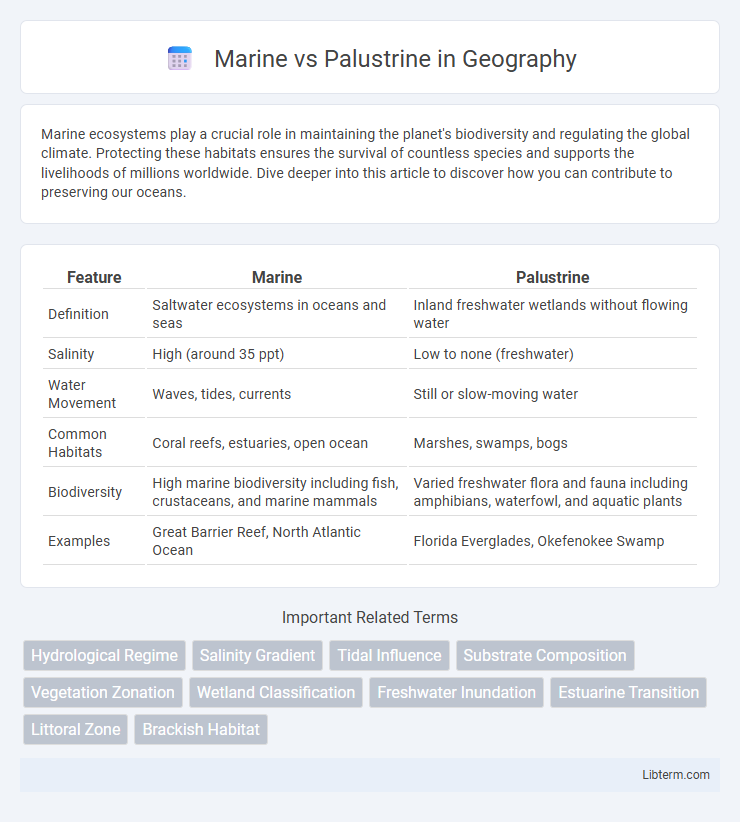Marine ecosystems play a crucial role in maintaining the planet's biodiversity and regulating the global climate. Protecting these habitats ensures the survival of countless species and supports the livelihoods of millions worldwide. Dive deeper into this article to discover how you can contribute to preserving our oceans.
Table of Comparison
| Feature | Marine | Palustrine |
|---|---|---|
| Definition | Saltwater ecosystems in oceans and seas | Inland freshwater wetlands without flowing water |
| Salinity | High (around 35 ppt) | Low to none (freshwater) |
| Water Movement | Waves, tides, currents | Still or slow-moving water |
| Common Habitats | Coral reefs, estuaries, open ocean | Marshes, swamps, bogs |
| Biodiversity | High marine biodiversity including fish, crustaceans, and marine mammals | Varied freshwater flora and fauna including amphibians, waterfowl, and aquatic plants |
| Examples | Great Barrier Reef, North Atlantic Ocean | Florida Everglades, Okefenokee Swamp |
Introduction to Aquatic Ecosystems
Marine ecosystems encompass vast saltwater environments such as oceans, coral reefs, and estuaries, characterized by high salinity and dynamic tidal influences supporting diverse marine species. Palustrine ecosystems consist primarily of freshwater wetlands including marshes, swamps, and bogs, distinguished by non-tidal, low-salinity conditions and saturated soils. These contrasting aquatic systems are critical for maintaining biodiversity, nutrient cycling, and water filtration within their respective terrestrial landscapes.
Defining Marine and Palustrine Environments
Marine environments are defined by saline waters predominantly influenced by oceanic processes, including tidal action, saltwater influx, and high salinity levels exceeding 30 parts per thousand. Palustrine environments consist primarily of freshwater wetlands such as marshes, swamps, and bogs, characterized by non-tidal, low-salinity conditions often with emergent vegetation and saturated soils. These environments are distinguished by their hydrology, salinity gradients, and biological communities adapted to either saline marine waters or freshwater wetland systems.
Key Differences Between Marine and Palustrine Systems
Marine systems are characterized by high salinity, tidal influence, and dominated by saltwater habitats such as oceans and seas, supporting diverse marine biodiversity. Palustrine systems consist of freshwater wetlands like marshes, swamps, and bogs, with low salinity and dominated by emergent vegetation and peat-forming plants. Key differences include salinity levels, hydrological dynamics, and vegetation types, which influence distinct ecological functions and species adapted to each environment.
Salinity Levels: Marine vs Palustrine
Marine environments typically exhibit high salinity levels averaging around 35 parts per thousand due to the presence of seawater, creating stable saline conditions essential for marine biodiversity. Palustrine systems, such as wetlands and marshes, usually contain freshwater with salinity levels well below 0.5 parts per thousand, resulting from limited saltwater intrusion and variable freshwater inflows. These contrasting salinity gradients heavily influence the distinct ecological communities and biogeochemical processes found within marine and palustrine habitats.
Biodiversity and Species Adaptation
Marine ecosystems host a vast biodiversity with species adapted to saline environments, such as coral reefs supporting complex symbiotic relationships and specialized fish with osmoregulatory abilities. Palustrine habitats, including freshwater marshes and swamps, sustain diverse flora and fauna adapted to low salinity and fluctuating water levels, featuring amphibians and plant species with aerenchyma tissues for oxygen transport. Species adaptation in marine environments often involves osmoregulation and pressure tolerance, whereas palustrine species exhibit adaptations to periodic drying and nutrient-rich but variable conditions.
Ecosystem Functions and Services
Marine ecosystems regulate global climate by sequestering carbon through extensive phytoplankton productivity and supporting diverse marine habitats essential for fisheries and biodiversity conservation. Palustrine ecosystems, such as freshwater marshes and swamps, provide critical water filtration, flood mitigation, and serve as vital breeding grounds for numerous wildlife species. Both ecosystems contribute to nutrient cycling and support human livelihoods but differ in salinity-driven species composition and hydrological dynamics.
Physical and Chemical Characteristics
Marine environments exhibit high salinity levels, typically around 35 ppt, with stable temperature ranges influenced by ocean currents, and contain a diverse mix of dissolved ions such as sodium, chloride, magnesium, and sulfate. Palustrine systems, including freshwater marshes and swamps, show low salinity (usually less than 0.5 ppt), variable temperatures, and higher concentrations of organic matter and nutrients like nitrogen and phosphorus due to terrestrial runoff. Oxygen levels in marine waters are generally consistent due to mixing, whereas palustrine waters may experience fluctuating dissolved oxygen caused by plant respiration and decomposition processes.
Human Impacts and Conservation
Marine ecosystems face significant human impacts such as overfishing, pollution from plastics and oil spills, and habitat destruction from coastal development, threatening biodiversity and ecosystem services. Palustrine wetlands, including marshes and swamps, suffer from drainage for agriculture, urbanization, and water pollution, leading to loss of critical water filtration, flood control, and carbon sequestration functions. Conservation strategies emphasize habitat restoration, pollution control, sustainable resource management, and legal protections to mitigate human impacts and preserve ecological integrity in both marine and palustrine environments.
Role in Climate Regulation
Marine ecosystems play a critical role in global climate regulation by sequestering vast amounts of carbon dioxide through oceanic phytoplankton photosynthesis and storing carbon in deep ocean sediments. Palustrine ecosystems, including marshes and swamps, contribute to climate regulation by acting as significant carbon sinks, trapping organic carbon in saturated soils and reducing greenhouse gas emissions. Both systems influence atmospheric carbon levels, but marine environments dominate long-term carbon storage due to their vast scale and deep carbon reservoirs.
Conclusion: Importance of Distinguishing Marine from Palustrine
Distinguishing marine from palustrine ecosystems is crucial for accurate environmental assessment, conservation strategies, and regulatory compliance. Marine environments, characterized by saline water and tidal influences, support distinct biodiversity and biogeochemical processes compared to palustrine systems, which are freshwater wetlands dominated by vegetation and hydric soils. Proper classification informs habitat protection, resource management, and mitigates ecological impacts caused by human activities.
Marine Infographic

 libterm.com
libterm.com